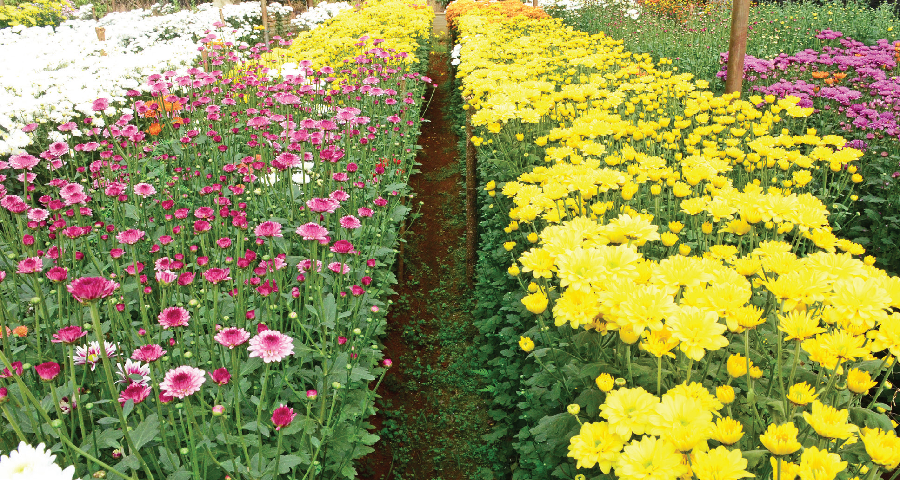With Goa being a hub for weddings and festivities, the demand for flowers continues to grow luring many a farmer into the floriculture business

With the ever increasing demand for decorative flowers for events and occasions, many of the agriculturists in Goa are turning into floriculturists. Known for its agricultural activities for decades, the Sattari taluka in Goa is now growing as a floricultural hub with many of the agriculturists turning their focus to growing exotic flowers in greenhouses. The primary crops here are usually areca nuts, coconuts, cashews, paddy and pepper but of late, flowers that have great demand in the event management industry are grown on a large scale. And the trend has certainly picked up in the past seven-eight years.
Villages in Sattari such as Velus, Hivre, Bambar, Dabos have taken to floriculture in a big way with the help of subsidies from the agriculture department. Young farmers especially have grabbed the opportunity and acquired the technical knowhow to grow flowers. Mandar Joshi from Bambar, started with a greenhouse in his backyard in November 2010. Today he is doing pretty well for himself. "I grow gerberas of various species, like danalian, balance, rosaline, dalma, sangria, salvadore and vintaqueen. The flowers appear after three months of planting. Good crop arrives in October, March, April and May," he says.
In great demand at festivals, marriages and other events, gerbera, which is a symbol of purity, happiness and bliss, is the fifth most used cut flower in the world (after rose, carnation, chrysanthemum, and tulip). Having a long vase life, they are widely used in the cut flower industry. Gerberas add colour to any room or garden. gerberas can be used in landscapes as bedding plants for borders and flower beds or as cut flowers for table arrangements.
Named after a German botanist and a medical doctor Traugott Gerber, it is a genus of plants from the daisy family (Asteraceae). Native to tropical regions of South America, Africa and Asia, the flowers are also called African lily. Gerberas vary greatly in shape and size and come in wide range of colours from light to dark yellow, white, orange, pink, brilliant scarlet, deep red and many more. Hybrid gerbera varieties have long-lasting flowers with thick peduncles that are not light sensitive; hence, flowers remain open in the dark, lending themselves to indoor use in flower arrangements.
The gerbera plant gives an average of around 30 flowers per year.This tender perennial plant is attractive to bees, butterflies or birds. It needs moist soil but not soaked, with extra water flown down.
"Since we grow them in greenhouses there is no fear of temperature change or insect invasion. Inside the greenhouse, a fair amount of manure, nutrients as well as pesticides keep the flowers in healthy condition and also free from diseases. These plants needs less space to grow, require less manpower but offers a bountiful of crop," explains Joshi.
Altaf Shaik, of Golden Leaf Agrotech, has started greenhouses in Velus where he grows cut flowers as well as the decorative leaves in 12 acres, half of which are occupied by orchids. "We have 18 types of orchid species including mokara, dendrobiam, spania and allconia," says Shaikh. "To grow the delicate mokara species of orchid, one needs specialised technological knowledge because this species survives only on the air. The plant absorbs nutrients that are sprayed on it." Shaikh has also other grown tropical flowers like ginger lily and helifunia. Shaikh's greenhouse grows anthuriums and semi tulip flowers (Thailand variety). The species like Sun of India, jana du, drasina ereka etc in decorative leaves are also grown here.
At Dabos, on the road to Sonal village, Anant Chodankar of Valpoi has built a greenhouse in 2015 to cultivate orchids and gerberas. Chodankar also grows zendu (Marigold) and shevanti (anthurium). His three greenhouses each measuring 1000 sq mts are a colourful sight, though the flowers have to be guarded watchfully.
Gajanan Gaonkar from Hivre has been involved in the commercial production of gerberas since 2015 in his greenhouse spread across 1000 sq feet area. "Currently the flowers fetch less demand in the market but once the marriage season starts, the demand will automatically surge," shares Gaonkar who supplies his flowers to Panaji, Bicholim and Marcel markets. The insecticides to spray on the plants are brought from Kolhapur and Belgaum, he mentions.
However, the flower market in Goa is affected by vendors from outside the State , laments Gaonkar. "These vendors sell their flowers at arbitrary price. There is no fixed rate. This affects the local growers," he states. Even so, farmers are still motivated to get into floriculture. "The government offers Rs 935 as subsidy for each sq mt area and so many of the farmers are motivated to opt for floriculture which is profitable. We have even the local, walk-in buyers, who prefer to purchase directly from us," states Gaonkar.
The growing floriculture in Goa is adding to its already scenic beauty. With blushing blossoms along the countryside, a ride or a tour is simply a joy. No matter what difficulties or struggles life poses before us, flowers act as great mood-lifters, making their surroundings pleasant by their mere presence.